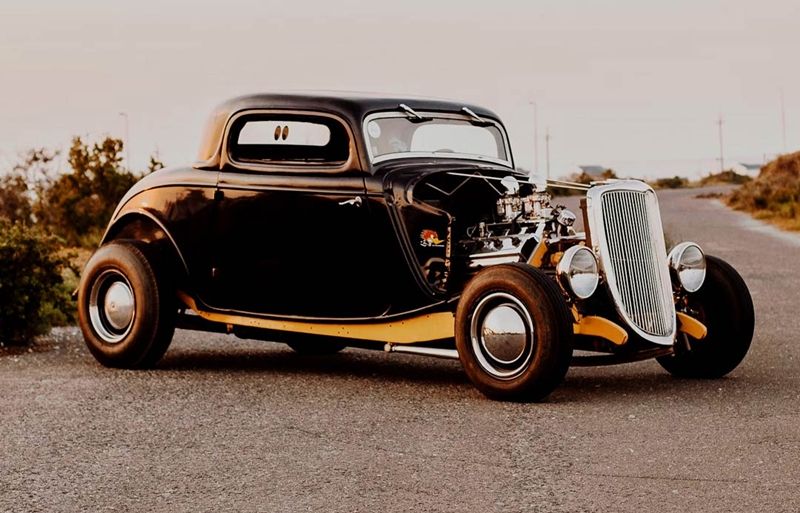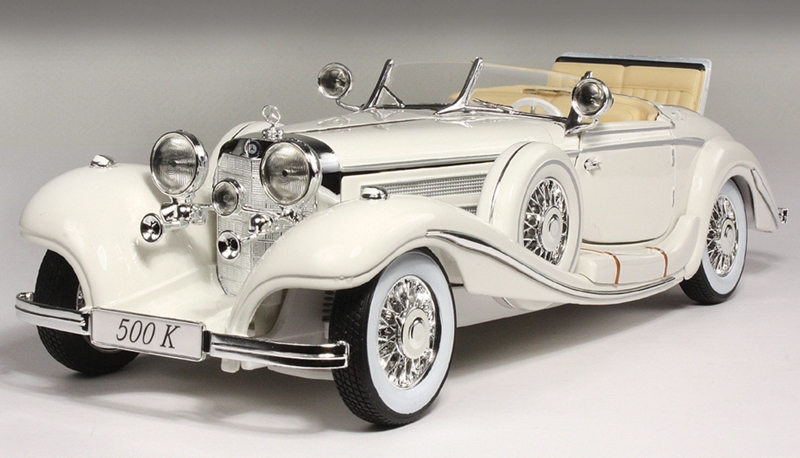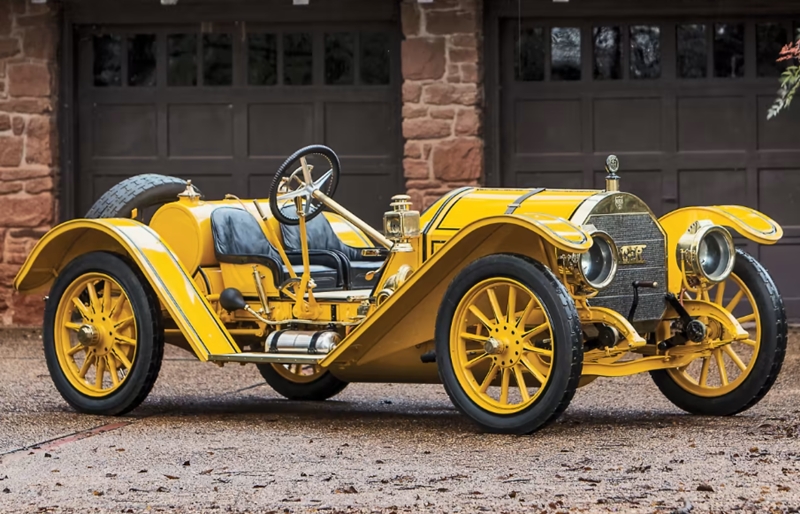The roar of engines, the smell of burning rubber, and the thunderous applause of crowds – welcome to the electrifying world of 1930s car racing. This remarkable decade didn’t just witness fast cars; it birthed legends, shattered records, and laid the foundation for modern motorsports as we know it today.
Also read: 7 Amazing Hot Rod History Secrets That Will Blow Your Mind
Picture this: it’s 1935, and you’re standing trackside at the Indianapolis Motor Speedway. The air crackles with excitement as sleek, powerful machines line up for what would become one of the most competitive eras in racing history. The 1930s car racing scene was unlike anything the world had ever seen, combining raw mechanical innovation with drivers who possessed nerves of steel and an insatiable hunger for speed.
1930s Technical Specifications Guide
Detailed engineering analysis of 1930s racing legends
Table of Contents
1930s Racing Statistics

Top Drivers of the 1930s
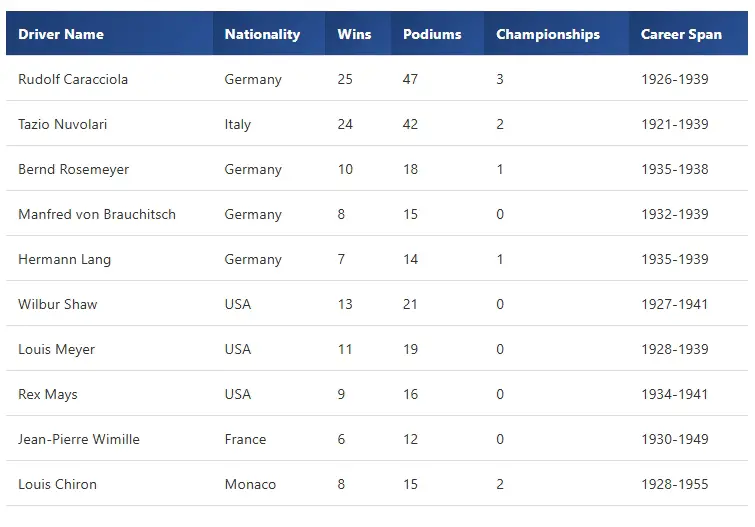
1930s Legendary Racing Cars
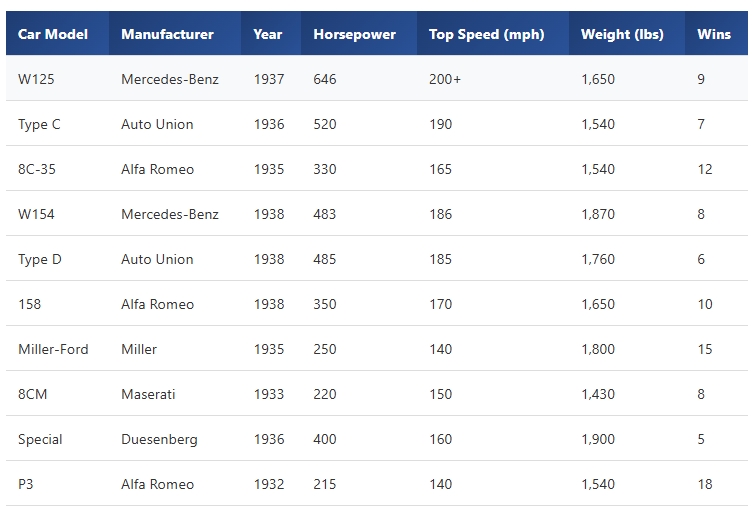
1930s Race Results
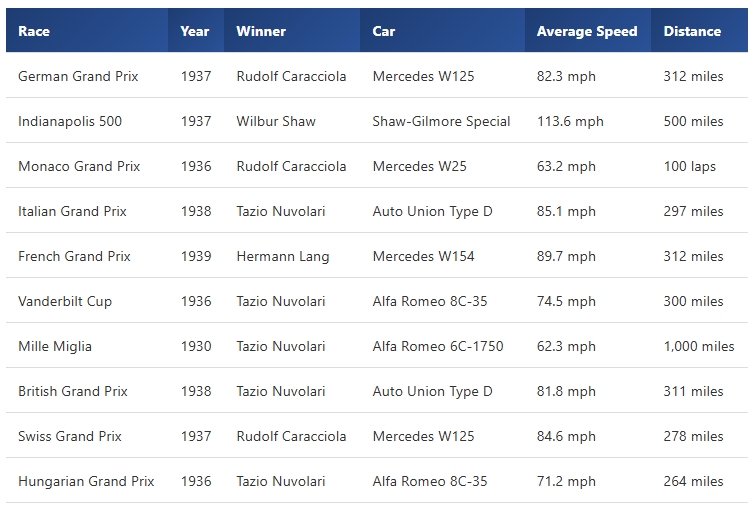
1930s Race Speed Records & Achievements

What made this decade so special? The answer lies in a perfect storm of technological advancement, economic necessity, and pure human ambition. As the world grappled with the Great Depression, racing provided an escape – a spectacle that reminded people that dreams could still soar, even when times were tough. Manufacturers poured resources into developing faster, more reliable vehicles, while drivers pushed these machines to their absolute limits.
The decade witnessed the rise of legendary figures like Tazio Nuvolari, Rudolf Caracciola, and Wilbur Shaw, whose names would forever be etched in motorsports history. These weren’t just drivers; they were gladiators of the racetrack, men who danced with death at speeds that seemed impossible for their era.

The Racing Legends Who Defined 1930s Car Racing Excellence
When we talk about automotive racing in the 1930s, we’re discussing an era dominated by titans whose skills behind the wheel bordered on the supernatural. These racing pioneers didn’t just drive cars – they transformed chunks of steel and rubber into poetry in motion.
Tazio Nuvolari, known as “Il Mantovano Volante” (The Flying Mantuan), epitomized everything thrilling about 1930s car racing. His fearless driving style and ability to extract maximum performance from any vehicle made him a crowd favorite across Europe. Nuvolari’s victory at the 1935 German Grand Prix, where he defeated the mighty German Silver Arrows on their home turf, remains one of motorsports’ greatest David-versus-Goliath stories.
Rudolf Caracciola brought a different approach to vintage car racing. The German driver combined technical precision with strategic thinking, earning him three European Championship titles during the decade. His mastery of wet-weather driving was so legendary that rain was often called “Caracciola weather” by racing enthusiasts.
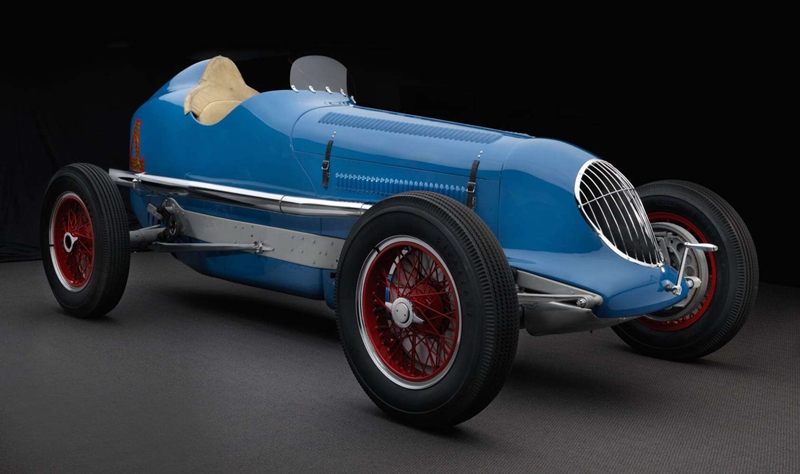
American racing wasn’t left behind in this golden age. Wilbur Shaw’s three Indianapolis 500 victories during the 1930s car racing era established him as one of America’s greatest racing heroes. Shaw’s smooth driving style and mechanical sympathy helped him dominate oval track racing when many European drivers struggled to adapt to American racing circuits.
These drivers didn’t just compete; they elevated automobile racing from a mechanical exercise to an art form. Their rivalries, friendships, and tragic losses created narratives that captivated millions and established racing as a legitimate sport worthy of international attention.
The 7 Shocking Secrets
- Government-Funded Racing Propaganda – Nazi Germany and other nations secretly used racing as political warfare, pouring massive government funds into teams like Mercedes-Benz and Auto Union to demonstrate national superiority.
- Depression-Era Innovation Explosion – Contrary to expectation, the Great Depression actually accelerated racing technology because manufacturers desperately needed marketing wins and had to innovate with limited resources.
- Primitive Cars with Modern Power – 1930s racing cars like the Mercedes W125 produced over 600 horsepower – more than many Formula 1 cars from the 1970s, despite “primitive” technology.
- Deadly Fuel Cocktails – Racing cars used extremely toxic fuel blends containing methanol and benzene that were far more dangerous than the crashes themselves, causing internal organ damage to drivers.
- Cross-Continental Racing Wars – Despite appearing separate, American and European racing had intense behind-the-scenes competition, with drivers secretly crossing over to compete on rival continents.
- Safety Was Actually Considered – Contrary to the “death trap” myth, teams did implement safety measures, but they were often hidden from public view to maintain the sport’s dangerous image for marketing.
- Racing Technology Time Travel – Many innovations from the 1930s (supercharging, aerodynamics, independent suspension) disappeared from racing for decades, only to be “rediscovered” and treated as new in the 1980s-2000s.

Revolutionary Car Models That Dominated 1930s Racing Circuits
The vehicles that graced racing tracks during this golden decade were engineering marvels that pushed the boundaries of what was mechanically possible. Classic racing cars from the 1930s weren’t just fast – they were rolling laboratories where manufacturers tested ideas that would eventually find their way into everyday automobiles.
The Auto Union Type C and Mercedes-Benz W125 represented the pinnacle of 1930s car racing technology. These German “Silver Arrows” produced over 600 horsepower from their supercharged engines – astronomical figures for their time. The Auto Union’s revolutionary rear-engine design challenged conventional thinking and influenced racing car development for decades to come.

Italian manufacturers like Alfa Romeo responded to the competitive pressures of 1930s car racing with their own masterpieces. The Alfa Romeo 8C-35 combined elegant design with formidable performance, proving that racing cars could be both beautiful and brutally fast. These machines dominated Grand Prix racing throughout the mid-1930s, establishing Italian automotive excellence on the world stage.
American automobile racing developed along different lines, focusing on durability and reliability for oval track competition. The Miller-Ford and Duesenberg racing specials that competed at Indianapolis represented a uniquely American approach to 1930s car racing engineering. These cars prioritized consistent performance over outright speed, reflecting the different demands of American racing circuits.
Each of these vehicles contributed unique innovations to automotive technology. Supercharging, independent suspension, advanced aerodynamics, and improved tire technology all emerged from the crucible of 1930s racing competition. The lessons learned on these racing circuits directly influenced the passenger cars that followed.

The Most Spectacular Racing Events of the Depression Era
The 1930s car racing calendar was packed with events that captured public imagination and created legends that endure today. These weren’t just competitions – they were cultural phenomena that brought communities together and provided hope during challenging economic times.
The Indianapolis 500 reached new heights of popularity during the 1930s, with attendance figures that wouldn’t be matched for decades. The 1936 race, won by Louis Meyer, attracted over 175,000 spectators who witnessed average speeds exceeding 109 mph – breathtaking velocity for that era. The event’s combination of American automotive ingenuity and fearless driving created an irresistible spectacle and helped define 1930s car racing in the United States.
European Grand Prix racing offered a different flavor of excitement. The German Grand Prix at the Nürburgring became legendary for its challenging 14-mile circuit that wound through the Eifel Mountains. Drivers faced over 170 corners during each lap, making it the ultimate test of skill and courage. Victories here were considered among the most prestigious achievements in 1930s car racing, drawing international attention and admiration.
The Mille Miglia represented yet another facet of 1930s car racing culture. This Italian endurance race covered 1,000 miles of public roads, transforming entire regions into temporary racing circuits. The event combined speed with strategy, as teams navigated everything from mountain passes to city streets while maintaining racing pace.
Monaco’s streets hosted what many consider the most glamorous race of the decade. The Monte Carlo circuit’s tight corners and unforgiving barriers created drama unlike anywhere else in racing. Success at Monaco required precision, patience, and nerves of steel – qualities that separated true champions from merely fast drivers.
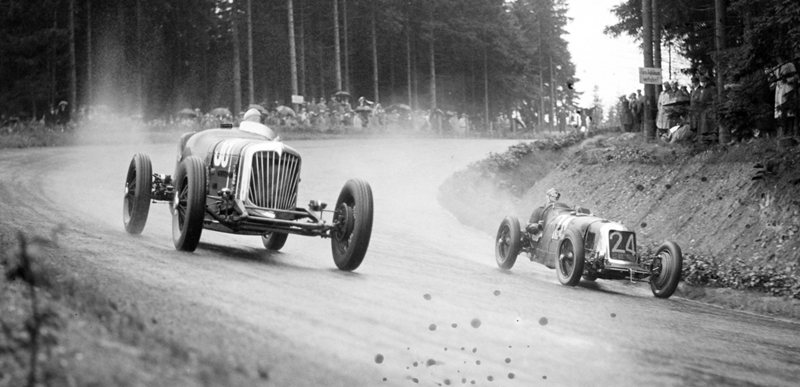
How the Great Depression Shaped Motorsports Innovation
While the Great Depression devastated many industries, it paradoxically fueled innovation in 1930s car racing. Economic hardship forced manufacturers and teams to think creatively, leading to breakthrough technologies that might never have emerged during prosperous times.
Manufacturers viewed racing success as essential marketing during tough economic conditions. Companies like Mercedes-Benz and Auto Union received significant government backing for their 1930s car racing programs, treating motorsports as a showcase for national technological superiority. This investment produced cars that were engineering marvels, incorporating cutting-edge materials and design concepts.
The economic pressure also democratized 1930s car racing in unexpected ways. Smaller manufacturers and independent builders found opportunities to compete against established giants by developing innovative solutions on limited budgets. This competitive diversity enriched the sport and accelerated technological development across the entire industry.
Racing teams became more professional during this period, adopting systematic approaches to car development and race strategy. The economic necessity of maximizing limited resources led to improved understanding of aerodynamics, engine tuning, and tire management – knowledge that benefited the entire automotive industry and raised the level of competition throughout 1930s car racing.
Sponsorship emerged as a crucial element during the 1930s, with tobacco companies, oil manufacturers, and tire makers recognizing racing’s marketing potential. These partnerships provided essential funding while establishing advertising models that modern motorsports still follow today.
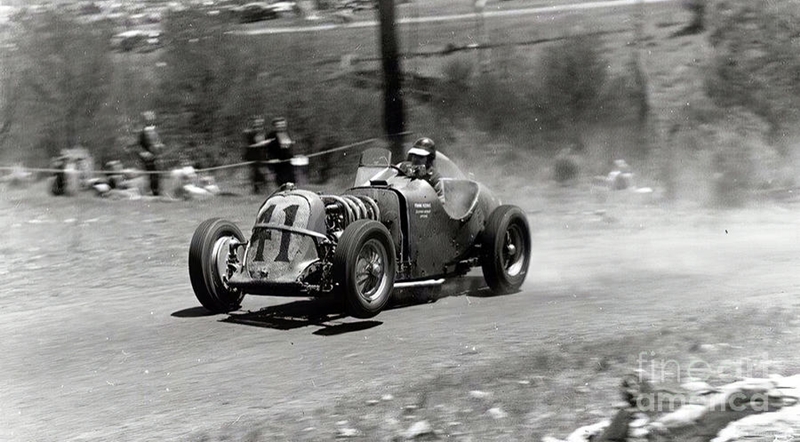
The Technology Revolution: Engineering Breakthroughs in 1930s Racing
The technological advances that emerged from 1930s car racing circuits were nothing short of revolutionary. Engineers pushed the boundaries of materials science, aerodynamics, and mechanical engineering in ways that fundamentally changed automotive design.
Supercharging technology reached new levels of sophistication during this decade. The Mercedes-Benz W125’s twin-supercharger setup produced power levels that wouldn’t be seen again in Formula racing until the 1980s. These forced-induction systems taught engineers valuable lessons about engine breathing, heat management, and fuel delivery that influenced automotive development for generations. Much of what we know about performance tuning today can trace its roots back to the experimental spirit of 1930s car racing.
Aerodynamics emerged as a critical performance factor during the 1930s. Teams began using wind tunnels to optimize car shapes, leading to the streamlined designs that characterized late-decade racing cars. The Auto Union’s distinctive silver bodywork wasn’t just beautiful – it was scientifically designed to slice through air with minimal resistance, another hallmark of innovation born from 1930s car racing.
Suspension technology advanced rapidly as teams sought to improve handling and driver comfort. Independent front suspension became standard on racing cars, providing better road holding and more predictable handling characteristics. These innovations quickly found their way into luxury passenger cars, improving safety and comfort for everyday drivers. The demands of 1930s car racing pushed engineers to develop more sophisticated chassis setups than ever before.
Tire technology evolved dramatically in response to the demands of high-speed racing. Manufacturers developed specialized compounds for different track conditions and racing distances. The knowledge gained from racing tire development improved passenger car safety and performance, making everyday driving safer for millions of people.
International Competition: When Nations Battled on the Racetrack
The 1930s transformed automobile racing from a gentleman’s hobby into an arena for international competition and national pride. Countries invested heavily in 1930s car racing programs, viewing motorsports success as a demonstration of technological and cultural superiority.
Germany’s Silver Arrows program represented the most ambitious national racing effort of the decade. Government funding enabled Mercedes-Benz and Auto Union to develop cars that dominated international competition throughout the mid-1930s. These victories served propaganda purposes while genuinely advancing automotive technology.
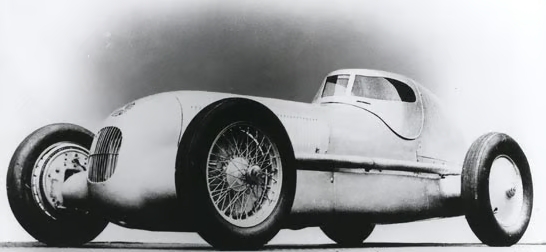
Italy responded with its own brand of 1930s car racing excellence, led by manufacturers like Alfa Romeo and Ferrari. Italian racing cars combined passionate design with sophisticated engineering, creating machines that were as beautiful as they were fast. The rivalry between German efficiency and Italian artistry created some of the decade’s most memorable racing moments.
British manufacturers took a different approach, focusing on lightweight construction and innovative design rather than raw power. Cars like the ERA (English Racing Automobiles) proved that clever engineering could compete with unlimited budgets, inspiring generations of British racing engineers and leaving a distinct mark on 1930s car racing history.
American racing maintained its unique character, emphasizing different values like durability and reliability over outright speed. The Indianapolis 500 remained largely separate from European competition, developing its own traditions and technological approaches that reflected American automotive culture.
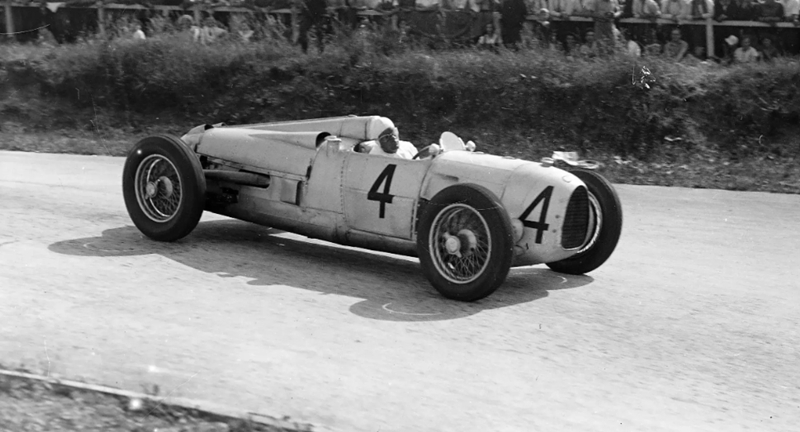
Safety Evolution: Learning from Tragedy in Early Motorsports
The 1930s marked a crucial period in 1930s car racing safety development, as the sport grappled with the inherent dangers of high-speed competition. While safety standards were primitive by modern measures, this decade saw the first systematic attempts to protect drivers and spectators.
Driver safety equipment evolved slowly but steadily throughout the decade. Leather helmets became standard, though their protection was limited compared to modern standards. Fire-resistant clothing remained rare, with many 1930s car racing drivers wearing ordinary street clothes during competition. These limitations led to tragic consequences that motivated future safety improvements.
Track safety received increased attention following several serious accidents. Barrier design improved gradually, though many circuits still featured minimal protection between cars and spectators. The tragic 1955 Le Mans disaster was still decades away, but warning signs were already apparent to observant safety advocates during the 1930s car racing era.
Car design began incorporating basic safety features during the late 1930s. Fuel tank placement received more consideration, and some manufacturers experimented with improved driver protection. However, these changes were often driven more by performance considerations than pure safety concerns in 1930s car racing.
The racing community slowly recognized that safety improvements didn’t have to compromise performance. Better brakes, improved visibility, and more reliable mechanical components actually enhanced competitive capability while reducing risk. This realization laid the groundwork for systematic safety development in later decades.
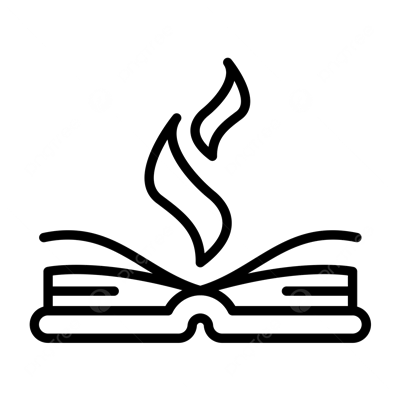
Myths About 1930s Car Racing Debunked
Myth 1: “1930s racing cars were primitive and slow”
Reality: Many 1930s car racing machines were more powerful than Formula 1 cars from the 1970s. The Mercedes-Benz W125 produced over 600 horsepower, while the Auto Union Type C could exceed 200 mph on suitable tracks.
Myth 2: “Racing was only for wealthy gentlemen”
Reality: While expensive, 1930s car racing attracted drivers from diverse backgrounds. Many successful drivers were professional mechanics or engineers who worked their way up through smaller racing categories.
Myth 3: “Safety was completely ignored”
Reality: While primitive by modern standards, 1930s racing did implement safety measures. Drivers wore helmets, cars had basic fire suppression systems, and tracks employed marshal systems to respond to accidents. Despite its dangers, 1930s car racing continually evolved to improve driver protection.
Myth 4: “American and European racing were completely separate”
Reality: There was significant crossover between American and European racing circuits. European drivers competed at Indianapolis, while American drivers participated in European Grand Prix events.

FAQ: 1930s Car Racing
-
What was the fastest 1930s racing car?
The Mercedes-Benz W125 holds the distinction of being the fastest, achieving speeds over 200 mph on suitable tracks. Its 5.7-liter supercharged engine produced approximately 646 horsepower.
-
Who was the most successful driver of the 1930s?
Rudolf Caracciola won three European Championships (1935, 1937, 1938) and is considered the decade’s most successful Grand Prix driver. However, Tazio Nuvolari is often regarded as the most talented.
-
How much did 1930s racing cars cost?
Top-tier racing cars cost between $15,000-$25,000, equivalent to $300,000-$500,000 today. This made racing extremely expensive and limited participation to well-funded teams.
-
What fuel did 1930s racing cars use?
Most used specialized racing fuel blends containing methanol, benzene, and other additives. These fuels provided more power but were extremely dangerous and toxic.
-
How long did races typically last?
Grand Prix races lasted 3-5 hours, while endurance events like the Mille Miglia took 10-16 hours. The Indianapolis 500 typically required 4-5 hours to complete.
Performance Comparison Chart

Championship Winners by Year

Need a mechanic? Find one on the Mobile Mechanic Directory

The Lasting Legacy of 1930s Car Racing
The influence of 1930s car racing extends far beyond the decade itself, shaping modern motorsports and automotive technology in ways that continue today. The innovations, personalities, and competitive spirit of this era established foundations that remain relevant nearly a century later.
Many technologies we take for granted in modern cars originated from 1930s car racing development. Supercharging, independent suspension, advanced braking systems, and aerodynamic design all emerged from the competitive crucible of Depression-era motorsports. Today’s Formula 1 cars are direct descendants of the Silver Arrows that dominated European circuits.
The decade established motorsports as legitimate entertainment and sporting competition. Professional racing teams, systematic car development, and international championship series all have their roots in 1930s car racing innovations. The marketing potential of racing success was recognized and exploited, creating business models that modern motorsports still follow.
Perhaps most importantly, the 1930s proved that automotive racing could thrive during difficult economic times. The sport provided hope, excitement, and inspiration when the world desperately needed positive distraction. This lesson remains relevant today, as motorsports continues to adapt and evolve while maintaining its core appeal.
The drivers, engineers, and visionaries of 1930s car racing created more than fast cars and exciting races – they built a cultural phenomenon that transcends mere competition. Their legacy lives on every time engines roar to life on racing circuits around the world, carrying forward the spirit of innovation and competition that defined this extraordinary decade.

